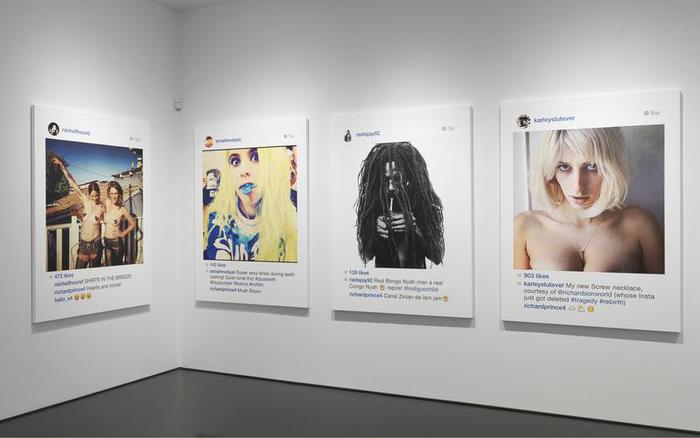
Richard Prince, “New Portraits,” installation shot, Sept. 2014, Gagosian 976, image:richardprince.com
According to his copyright infringement lawsuit against Richard Prince, Rasta-fetishizing fashion photographer Donald Graham sells limited edition prints of his 1997 photo, Rastafarian Smoking a Joint in two sizes: 20×24 inches (ed. 25) and 48×60 inches (ed. 5).
A rasta/model/whatever named @indigoochild ‘grammed Graham’s image in February 2014. It was regrammed in May by another r/m/w, @rastajay92, three months later. In May Prince commented on it, then took a screenshot, which he eventually printed at 4×5′ and showed in his “New Portraits” show at Gagosian Madison in September 2014.
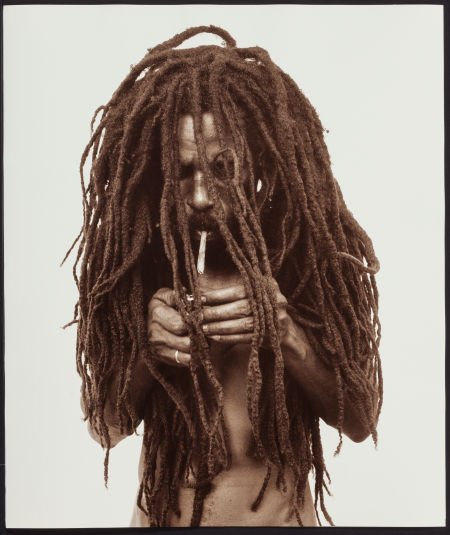
Donald Graham, Rasta Smoking A Joint, 1997-, Lambda print, 20×24, ed. 5/25, sold at Heritage Auction in Nov. 2015
In his complaint, Graham’s attorneys detail the alterations Prince made to Graham’s image, including making a screenshot, cropping, adding text and emoji, adding all the UI and empty space, and printing at low resolution and large size on canvas. Prince’s depiction is clearly of a photo on/in Instagram, with all that entails. It is clearly different in appearance, color, finish, and context, unless you’re seeking a significant amount of money, in which case these differences become invisible or irrelevant.
Unfortunately for Mr. Graham, he only registered his copyright for the image after Prince’s show, so even if he were able to prove infringement, he would only be able to recover actual damages. Since Prince sold his New Portrait to his dealer Larry Gagosian, those actual damages probably range between the profit from one 4×5 photo print and $18,500, Prince’s half of the $37,000 retail price for the IG works at that time.
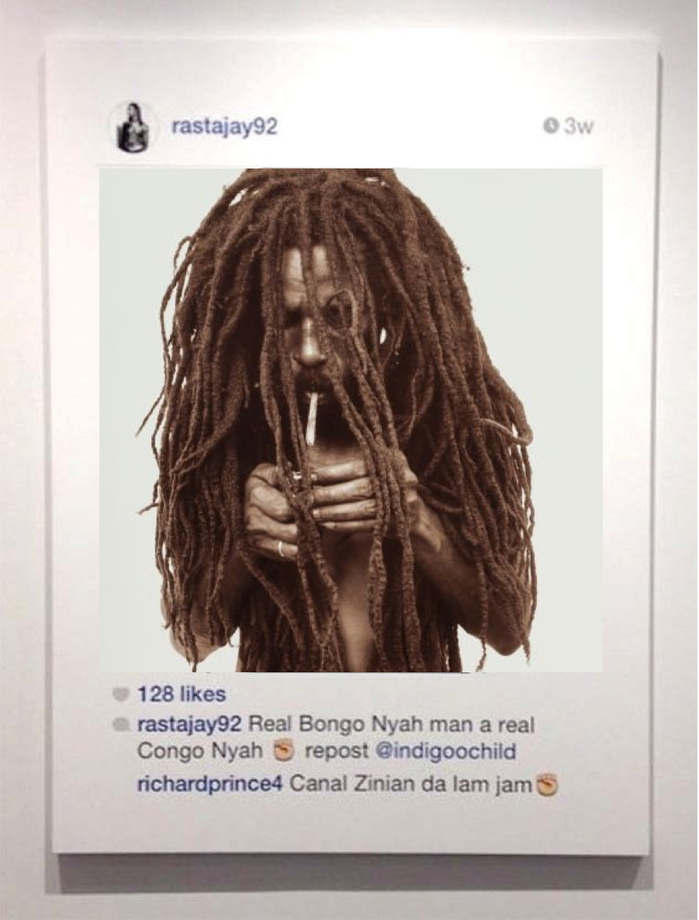
greg.org, Study for Untitled (Re: Graham), 2016, Donald Graham Lambda print cut down and collaged on inkjet on canvas, 30×24 in., ed. up to 25, I guess
It strikes me that the quickest and easiest solution is to buy one of Graham’s prints, cut it up, and collage it on top of the infringing Prince. They’re already roughly the same size. For proof of concept, I’m glad to make a study using one of Graham’s smaller, 20×24-inch prints. As it happens, the only two ever to come to auction surfaced after Prince’s show: in November 2014 in Paris (EUR2600), and in Nov. 2015 in Dallas ($2,475). Delivery date’s a little uncertain, but at these prices, I’m sure we can make it work. Win-win-win.
Category: projects
Untitled (Glafira Warhol), 2015
Dan Duray has an excellent scoop on an unheralded auction last spring to liquidate the art collection of Glafira Rosales, the only person convicted so far in the Knoedler Gallery forgery scandal.
About 236 lots were sold by the US Marshals via their auction contractor. Only one, a portrait of Rosales herself, betrays any connection to the caper, but that doesn’t mean they’re unrelated. Most of the works were bought at auctions since 2010, which means they were presumably bought with proceeds from Rosales & co’s fake postwar masterpieces.
The obscurity of the sale and the omission of the works’ criminal connection practically demand a Glafira Rosales Provenance Project. Maybe in the new year.
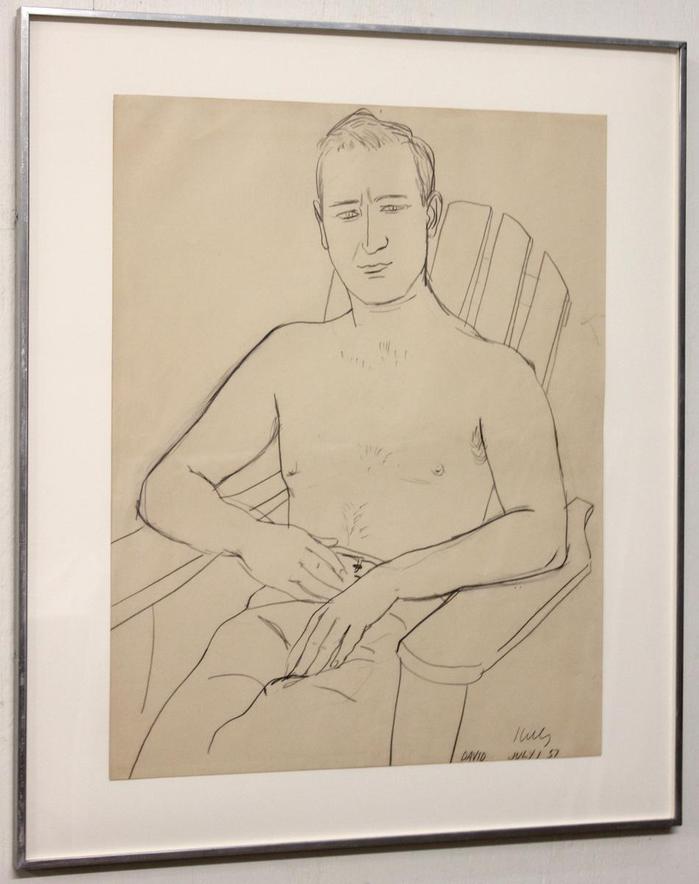
Right now, though, I’ll just call out two fascinating works:
This 1957 drawing by Ellsworth Kelly is of David Herbert, a dealer and gallery employee who worked with key NY figures like Betty Parsons, Sidney Janis, and Richard Feigen. Herbert was also dragged into the center of the Knoedler scam; Rosales claimed that Herbert, who died in 1995, was the source for the paintings, which she said belonged to an anonymous, but totally fictitious, European collector. As Patricia Cohen described it when the Knoedler forgeries began to surface:
Herbert planned to use the works to stock a new gallery that was to be financed by the original collector. But the two men had a falling out, and the art ended up in the collector’s basement until his death.
Ms. Rosales does own a 1957 line drawing of Herbert by Ellsworth Kelly that was recently part of an exhibition at the Brooklyn Museum. What she does not seem to have, however, are any records that track the ownership of the two dozen or so Modernist paintings she brought to market.
Rosales had been introduced to Ann Freedman, Knoedler’s president, Cohen reported, by a gallery employee Jaime Andrade. Andrade was Herbert’s partner. He was, presumably, the one who sold or gave Kelly’s portrait of Herbert to Rosales. This is how provenance is made: it is inferred along a chain of relationships.
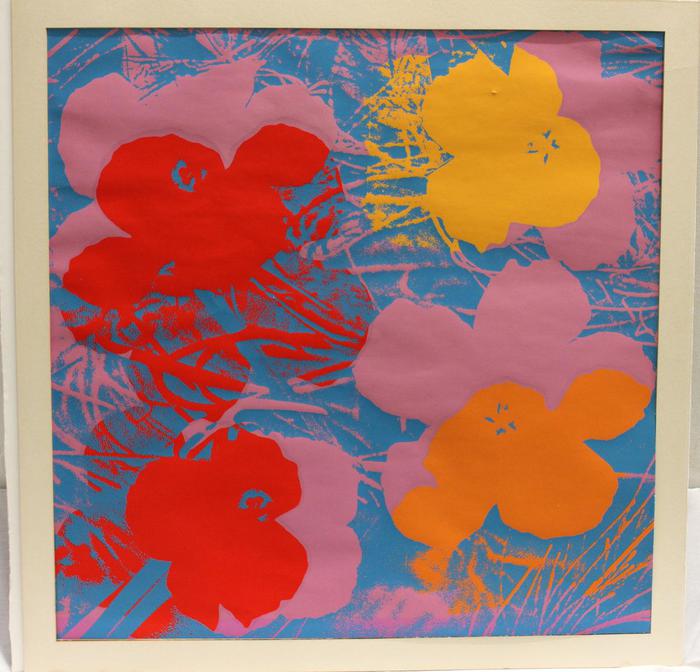
The other work is now my favorite. It is so perfect I have made it my own. Untitled (Glafira Warhol), 2015, is a poster for “Look at Warhol,” a 1970 exhibition at Galerie Thomas in Dusseldorf. It’s hard to top the Marshal’s lot description
Sheet folded at text in top margin and hinged to mat, full sheet = 35.75” x 26.75”. No frame, non-archival mat only.
That’s right. The master forger and con artist who sold dozens of modern masters to the most venerable gallery in the country without detection also folded a Warhol poster into a mat from Michael’s and tried to pass it off as a Warhol print.
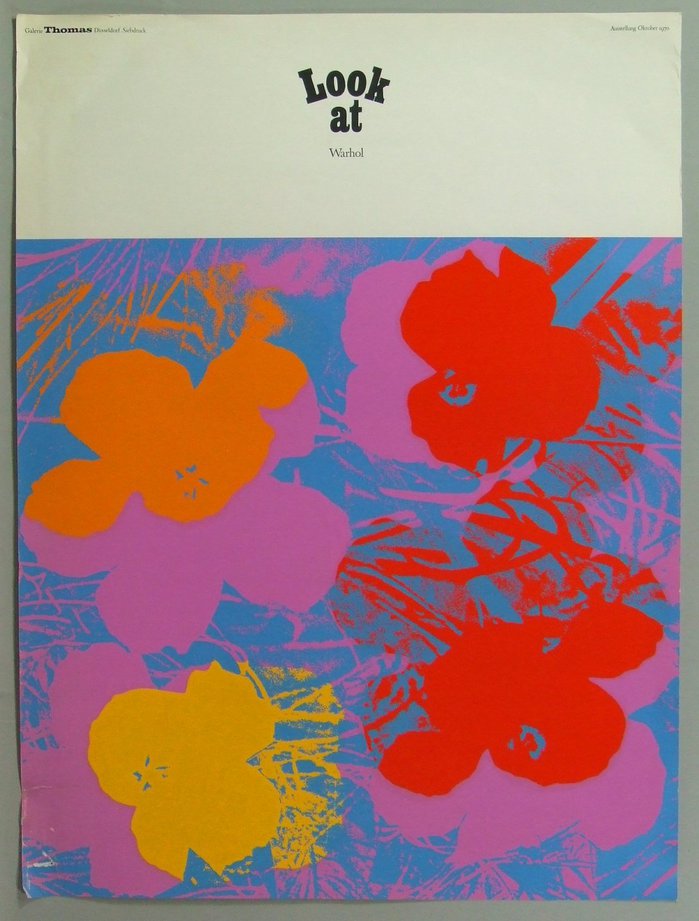
In Glafira’s defense, she is not alone. The web is littered with these posters, which art grifters pretend is worth $1,500 or more, even as they sell from vintage poster shops for less than fifty bucks. The Marshal appraised Glafira’s handiwork at $85. It sold for $905. I can only assume it is because an astute connoisseur recognized the brazen shittiness of the hack as the ultimate souvenir of the whole Knoedler affair.
And while the original now resides in an unknown private collection, I will make Untitled (Glafira Warhol) as an authentic replica edition object as soon as the posters arrive.
Secret fire sale held of 250 works confiscated from dealer in Knoedler gallery scandal [theartnewspaper]
LOT: 104 (1) DRAWING: Ellsworth Kelly (1923 – ) Portrait of David Herbert 1957, sold for $15,200 [txauction, note: dead txauction links updated to archive.org]
LOT: 142 (1) SERIGRAPH POSTER: Andy Warhol [txauction]
Glafira Rosales’ collection runs from Item number 18381 to number 18616 [txauction]
Previously, 2013: What You See Is What You Believe: Barnett Newmans From The Knoedler/Rosales Collection
2012: Here’s that Knoedler Gallery Rothko
Untitled (Joan Collins Toile de Jouy), 2015
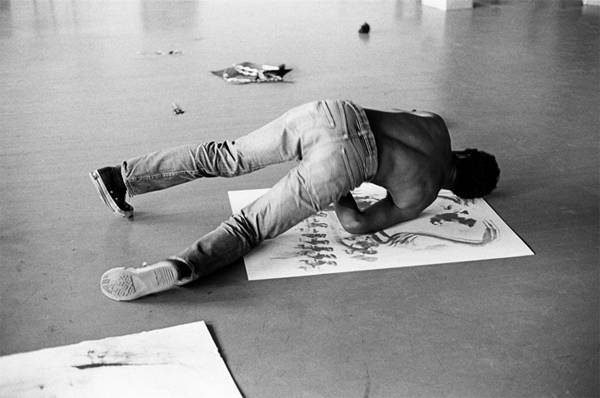
David Hammons Slauson Street Studio, Bruce Talamon, 1974, image: roberts and tilton
Like Jasper Johns a decade before him, David Hammons made prints of his oiled body. Hammons’ were more narrative, rich with content beyond just the impression of the artist’s own body.
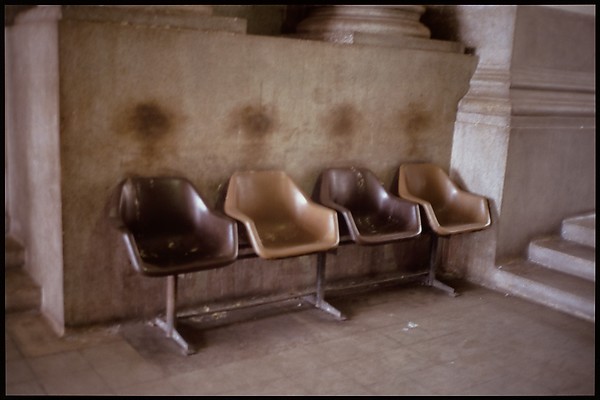
Waiting Chairs, Gabriel Orozco, 1998, image: metmuseum.org
As is his wont, Gabriel Orozco found his narrative, this time in India, in the stone wall darkened by contact with the hair of people who rested against it as they sat in these seats. We don’t know who they were.
I am pleased to introduce a work that combines these two threads of presence and absence, specificity and universality, anonymity and celebrity, found object and markmaking.
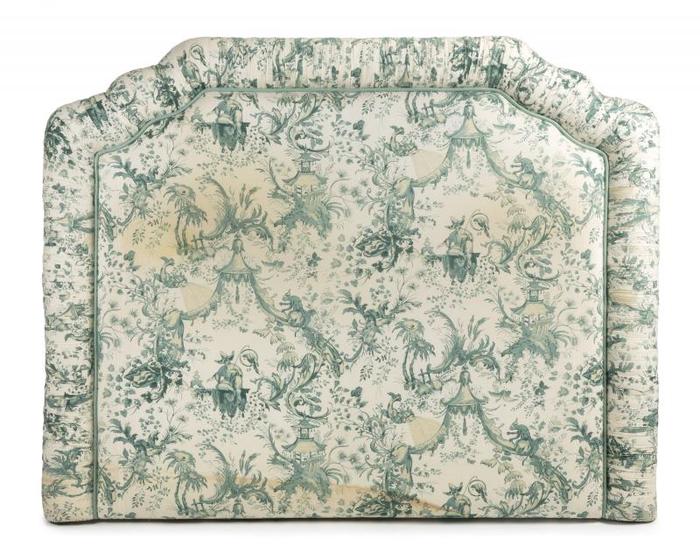
Untitled (Joan Collins Toile de Jouy), 2015, 59 x 72 inches, patinated toile de jouy fabric, stuffing, wood
Untitled (Joan Collins Toile de Jouy) is a shaped work, a painting, really, comprising an upholstered headboard from Ms. Collins’ New York apartment, altered in collaboration over the years by her and, apparently, occasionally, (an)other(s).
Interested parties, or at least those interested in having physical custody of the work, should contact me quickly, before the 14th. That’ll give us enough time to get the headboard from the auction in LA. Me, I’m happy with it right where it is. And wherever it ends up.
Lot 43: JOAN COLLINS TOILE DE JOUY HEADBOARD [julienslive.com]
Previously, related: Untitled (Merce At The Minskoff)
More eBay Test Listing Prints, Less Time
Untitled (141831674795), formerly known as: Beer statue TEST – DO NOT BUY
I haven’t written much about the eBay Test Listings project here since eBay shut it down and forced it into a different configuration. I’m happy to have it exist primarily on eBay, where it conspires against itself, making success and failure interchangeable.
ceci n’est pas 600px: just noticed it’s actually 500px
They don’t search well. The titles are opaque. The pricing across the series makes people wonder. And after surfing through the 800 even less expensive items in the “photographs > directly from artist” category, it turns out these aren’t always even the most eye-popping.

So it really does come back to their unique situation, unlike literally every other thing on eBay: they were specifically made and chosen to not be sold. To not be found, and to not be found attractive. At least to a bidder or buyer. Yet they are still made and chosen in some way, for some surpassing reason beyond their function. [An image is required for every eBay listing, even a test listing with nothing to sell.] And so I’m intrigued by the otherwise invisible images made by otherwise invisible people, which are intended to be seen by no one but themselves and maybe their colleagues, and their bots.
Really I just wanted an excuse to post that [bear+deer=] beer statue picture.
eBay Test Listing prints for sale, only through Art Basel Miami, though [ebay]
Previously, all eBay Test Prints-related posts, in chronological order:
7 March 15: Untitled (DO NOT BID OR BUY)
18 March 15: Proposte monocrome, ebay, rose
16 April 15: DO NOT BID OR BUY Meets DO NOT LIST OR SELL [includes CR]
7 May 15: eBay Test Listings, Reviewed
30 July 16: New eBay Test Listings Prints
10 September 15: Prince & Prints at Internet Yami-Ichi 9/12
“Untitled” (Crystal Bridges), 2015

“Untitled” (L.A.), FKA “Untitled” (Rossmore) image via christies
Howard Rachofsky bought Felix Gonzalez-Torres’ 1991 candy pour, “Untitled” (Rossmore)” in 1998. It consists of green wrapped candies spread on the floor with an ideal weight of 50 lbs. That was presumably the title when Ranbir Singh purchased it in 1991, and when he sold it in 1998, even though the 1997 catalogue raisonne lists it as “Untitled” (L.A.). [Another candy pour from 1991, also with green candies, but an ideal weight of 75 lbs., bears the orphan title “Untitled” (Rossmore II).] Rachofsky loaned his pour to the Modern Art Museum in Fort Worth, and exhibited in a bathtub of his Richard Meier-designed house.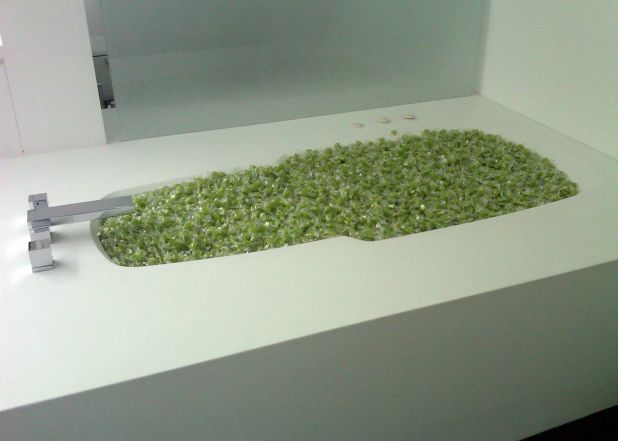
Felix Gonzalez-Torres, “Untitled” (L.A.), 1991, as installed in Howard Rachofsky’s tub, image by Andrea Duffie via forthworthanewperspective
Rachofsky and his wife donated or pledged the house and much of his collection to the Dallas Museum in 2005-Cindy Rachofsky specifically mentions the Felix piece in this interview-so it’s frankly baffling that he sold “Untitled” (L.A.) last week at Christie’s, even if it did bring $7.7 million. But DFW’s loss is Bentonville’s gain. [2024: updated dead url on that Cindy Rachofsky interview]
ArtNEWS reports the buyer of “Untitled” (L.A.) is Alice Walton’s Crystal Bridges Museum of American Art. I would imagine that the politics of the Wal-Mart heir would have pissed off and/or inspired Felix to no end. But after re-reading his 1995 interview with Rob Storr about politics and culture and audience, and how he wanted to operate like a spy, I think he’d see the acquisition of his work by Crystal Bridges as a triumph. He has successfully infiltrated the beating red state heart of America’s conservative plutocracy.
Of course, in the 20 years after the artist’s death, the cultural terrain has shifted, and if it doesn’t exactly end up being the wrong one, the mountain Felix scaled offers views of still higher, more difficult peaks.
“Untitled” (Crystal Bridges) Wal-Mart money (endless supply) dimensions variable ideal weight: 50lbs [artnews tweet]
— gregorg (@gregorg) November 16, 2015
And so it occurred to me almost instantly to make another piece, inspired by Walton’s “Untitled” (L.A.) acquisition: “Untitled” (Crystal Bridges) consists of Wal-Mart money, free for the taking and endlessly replenished, with an ideal installation weight of 50 lbs. It could be a pour, but it probably works best in Felix’s other trademark form, as a stack piece. It looks a bit like “Untitled” (Passport #II), but with cash instead of little booklets.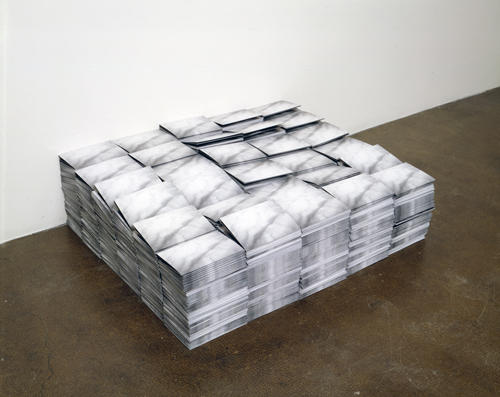
“Untitled” (Passport #II), 1993
A US banknote weighs just under a gram, so 50 lbs is around 25,000 bills. They should all be of the same denomination, whether it’s singles ($25,000) or $100s ($2.5 million), as long as there is an endless supply.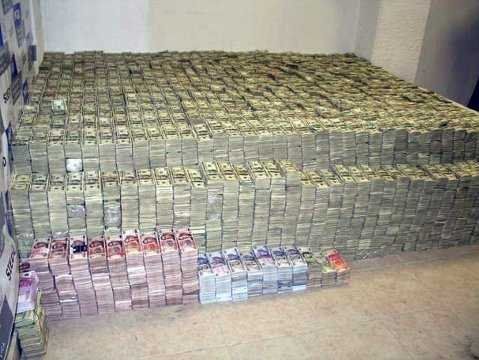
$207 million of Sinaloa drug cartel cash weighed 4,500 lbs, not an ideal weight for the sculpture, but I’ll leave that to the owner’s discretion.
Since the Walton family only has $147 billion right now, they’ll have to manage the installation with an eye on both ROI and replenishment rates. I’m sure they can do it.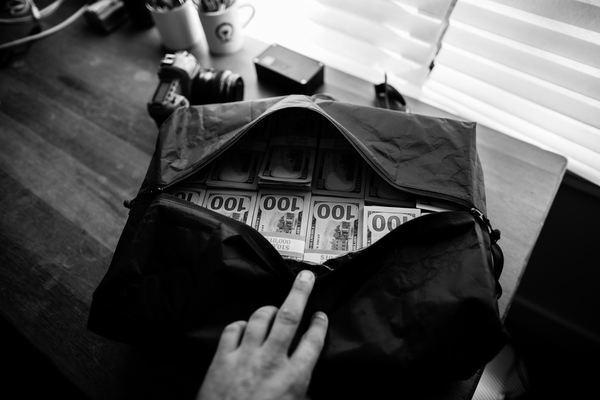
image of 1M Hauly from SDR Traveller
I’ve rebooted Felix works before, but I think the idea for this piece crystallized so immediately because I’d been primed to consider the spatial implications of a million dollars in cash. Just a few days ago, Michael Sippey tweeted about the 1M Hauly, a high-performance duffel bag by SDR Traveller optimized for the secure, discreet transport of $1 million, in 10,000 $100s.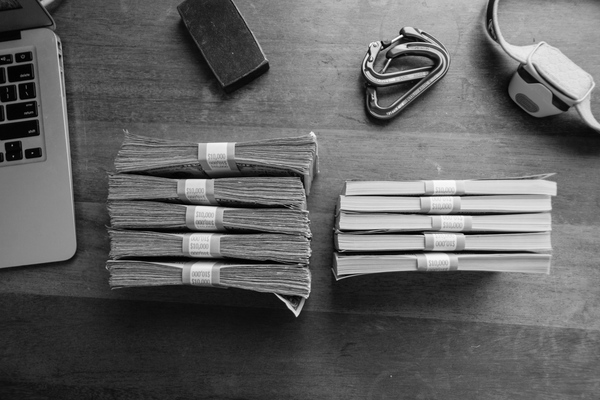
fat v. flat, via SDR Traveller
Turns out used, street, dirty money takes up as much as 40% more space than crisp, fresh bank product, but the 1M Hauly can handle it all. When strapped, 10,000 bills fits into a 20.4 lb cube 18x12x6 inches. So if it were stacked, “Untitled” (Crystal Bridges) could be an 18×18-in square about 10 inches high. It’s an adorable scale, domestic, almost intimate, which will provide endless [sic] enjoyment and engagement for museum visitors. As long as they don’t get too grabby. And as long as the Waltons don’t go broke.
[I haven’t exactly asked, but I bet SDR Traveller would be willing to discuss the commission of a custom-sized travel bag for “Untitled” (Crystal Bridges). Interested collectors should get in touch with me for details.]
uncut sheets of new $100 bills at BEP in 2013, image: AP/LM Otero
UPDATE: OR, maybe there is another way. Uncut currency sheets sell for a premium from the Bureau of Printing & Engraving, but they’d really give the piece a Felixian feel. The ideal height for a stack of 32-note sheets like the ones above would be about 775 sheets, about 6 inches. The BEP online store only has 16-note sheets, though, for $1,800 each. See if you can get a volume discount, or a subscription.
Previously: On Politics and Art
suddenly related: “Untitled” (Orpheus, Twice), 2012
RPFleaMarket
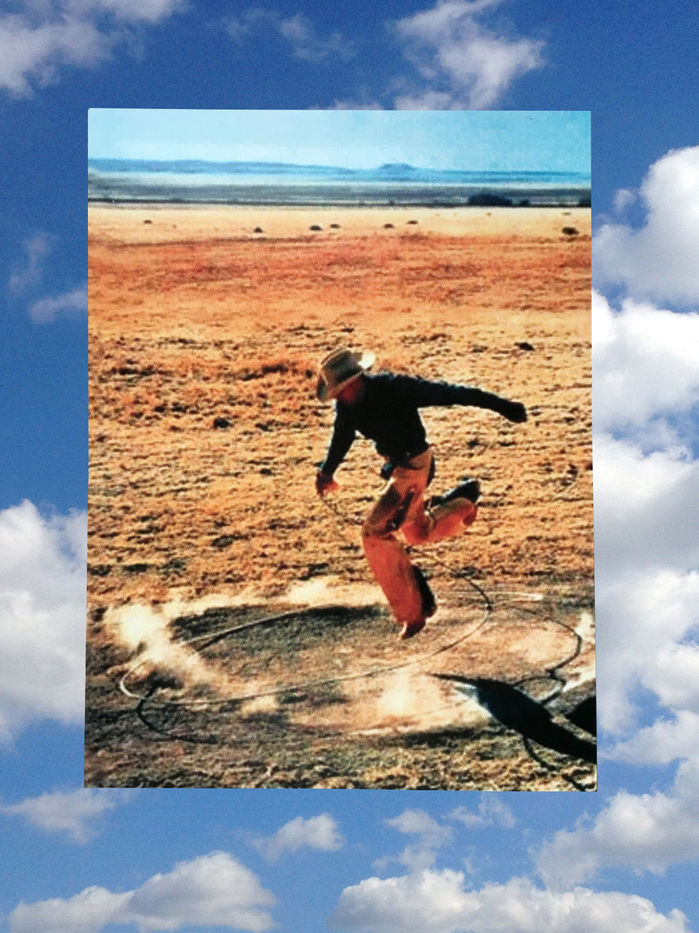
A few weeks ago Eric Doeringer asked me to contribute to a project, RPFleaMarket, that poured Richard Prince-related appropriation objects into the eBay mold of Rob Pruitt’s Flea Market. It’s pretty awesome, and like Rob’s own joint, everything comes with an autographed photo of the item for sale.
So if a never-released Untitled (300×404) proof printed on aluminum is not enticing enough for you, this one comes with a glossy 8×10 photo of it, suitable for framing!
There are also a couple of one-off hand-altered editions of the Cariou v. Prince documents, and a whole host of interesting objects, artifacts, publications, and LMAO IDKs. Check it out on Eric’s eBay page.
Cowboy Photograph by Greg Allen [sic] not RICHARD PRINCE Appropriation RPFleamarket, current bid $45.44, ends Nov. 12 [ebay]
Untitled (On A Clear Day), 2015 –
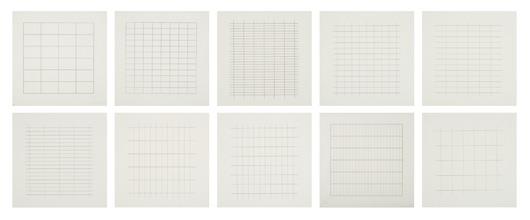
They are not the kind of thing to get excited over, necessarily, but every time I think about Agnes Martin’s 1973 screenprint portfolio On A Clear Day, I like them a lot. [I did not like seeing a complete set baking in the sun in someone’s freshly renovated loft kitchen one time, though. Respect, people.]
Martin had given up painting for seven years, and the invitation from Luitpold Domberger to create a print portfolio was instrumental in Martin’s decision to start making work again. [That she was also preparing for her first mid-career retrospective at the ICA in Philadelphia at the time might have helped. I guess we should read the new biography and find out.]
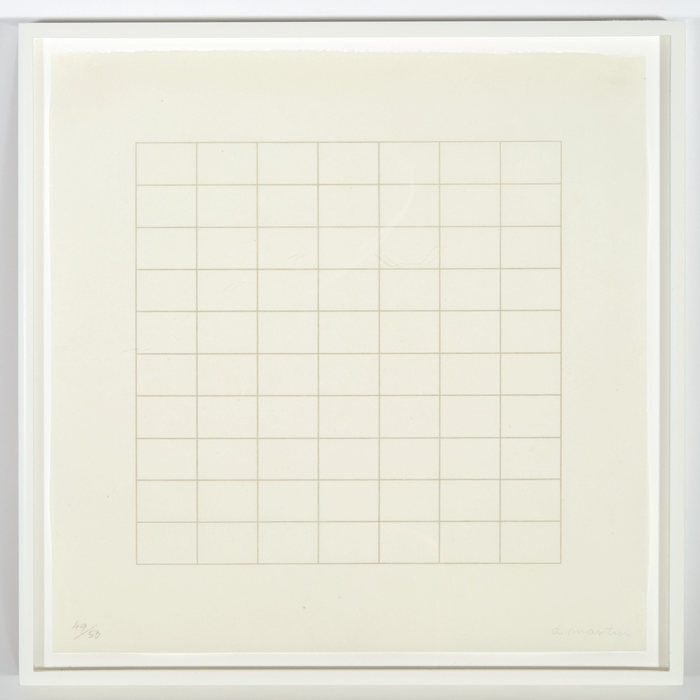
Anyway, On A Clear Day is 30 images Martin selected from over 300 drawings she’d done in 1971. So a subset, perhaps, more than a series. And a mechanical interpretation of her hand marking process.
The 8×8 prints on 12×12 sheets are printed in an edition of 50, plus 14 APs. It is not clear how many portfolios were kept together, but a bunch were broken up, and loosies show up at auction all the time. One’s coming up at Doyle in a couple of weeks, in fact: plate 8 from ed. 49/50. The estimate seems a bit low, but it says there’s a soft crease in the image.
I hate broken up sets, and have long wondered if you could put one back together. And by you, obviously, I mean me. How long would it take? Could you track them down, or do you just have to wait and watch? Which number should you work on? Should you keep a stash of loosies available anyway, to trade with reluctant sellers?
What have these prints been through since they’ve been apart? Have they been cared for, kept out of the sun? Framed nicely? Framed crappily? Lone silkscreens are not very precious. And there are nearly 2,000 of these things out there. Some might be shoved in drawers, or stuck inside a book. Isn’t it likely that some might not have survived at all? If there are already a couple dozen complete sets around, what’s the value to Martin’s legacy of one more?
But I guess it’s not really for or about Martin at all. She just provided the raw material for the project. If a reassembled Agnes Martin portfolio is a new work, Untitled (On A Clear Day), would an assemblage of mismatched Martin prints be a study?
I remember very well the set of ten On A Clear Day prints up top, which were at Phillips in 2008. They are a ragtag bunch of misfits, actually: three “a.p.s,” six “p.p.s”, and only one actual numbered print: plate 4 from, oh hey, 49/50. This project may start right now.
Oct. 27, 2015: Lot 125 Agnes Martin (1912-2004), ON A CLEAR DAY, est. $1,000-1,500 [doylenewyork]
Untitled (Merce At The Minskoff), 2015 – 2018
 Untitled (Merce at the Minskoff), 2015 – 2018 , ink on towel with four signatures (interim state)
Untitled (Merce at the Minskoff), 2015 – 2018 , ink on towel with four signatures (interim state)
Sometimes an object has its own logic.
A few days ago I saw an unusual auction listing. It was described as a “textile” with the title, “Merce at the Minskoff,” and it was signed by “Bob Rauschenberg, Merce Cunningham, and John Cage.” But the description was cursory, and there was no image. When I called, the small downtown auctioneer couldn’t describe it, but they assured me they’d post the image soon.
This textile was clearly related to Merce and the company’s week-long performance at the Minskoff Theater in January 1977, the only time they performed on Broadway. But what would be signed by these three?
Then I got wrapped up in other stuff, and confused the sale date, and long story short, I missed the auction this morning, and I lost a chance to buy what appears to have been an autographed commemorative hand towel.
So for now getting the designer of the Merce at the Minskoff poster to sign this towel requires not just the acquiescence of Mr. Johns, but the co-operation of the as-yet-unidentified owner/custodian of the towel.
But it will happen. Or at least it must. Because when an object has its own logic, your only viable option is to endeavor to realize it as quickly as possible.
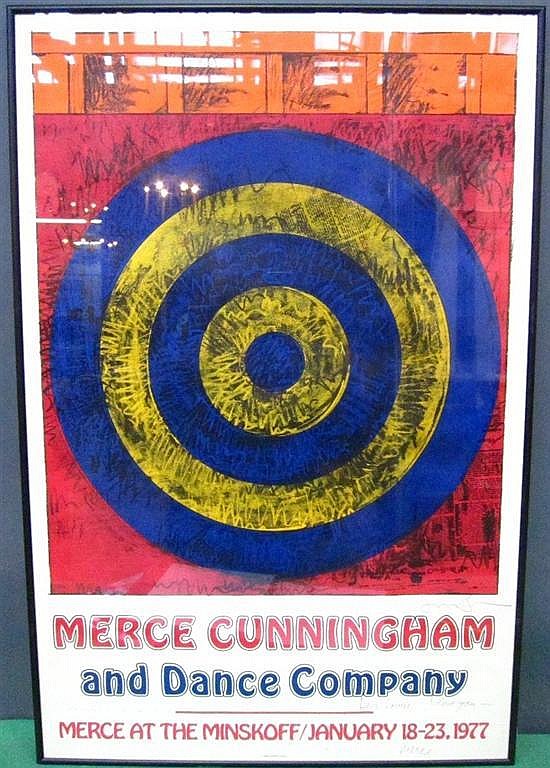
FROM THE ESTATE OF LOUISE NEVELSON HELLO: “Signed Jasper Johns lower right and inscribed, ‘Dear Louise, I love you, Merce”
Lot 194: Textile, “Merce and the Minskoff”, sold for a measly $125 to someone now carrying the weight of future Art History on his or her shoulders [roland/liveauctioneers]
Apr 26, 2010, Norwalk, CT, Lot 357: AFTER JASPER JOHNS (AMERICAN, b.1930): Signed colored poster. [braswell/invaluable]
UPDATE: This post was edited soon after publication to accept responsibility for an object’s realization, even though it is not presently within my control to do so. I must and will do what I can.
APRIL 2016 UPDATE: I was discussing this work with my wife recently; she takes issue with this entire project of asserting art status upon an object beyond my control or ownership. She questioned my claim thus: “Why didn’t he sign it? If he designed the poster, it can’t be for lack of opportunity. That’s the logic of this object: that he didn’t sign it.”
Reader, I married her.
UPDATE UPDATE: Several months ago I received updated information about the towel and its situation. Upon renewed contemplation of the logic of this object, I determined an appropriate course of action, and followed it. As Jasper Johns wrote, “Take an object/ Do something to it/ Do something else to it [Repeat]” And now here we are. All of those involved have my sincere gratitude and respect. I am psyched to report that as of May 4, 2018, this work has been completed.
Prince & Prints At Internet Yami-Ichi New York 9/12

I am bewildered and psyched in equal parts to announce the presence of some greg.org objects at Internet Yami-Ichi New York, this coming Saturday (9/12) at Knockdown Center in Maspeth.
Michael Sarff from MTAA invited me to show some black-marketable items in Over The Opening (OTO) a space (blanket) he is curating, so I sent along the following:

Hand-colored editions of Canal Zone Richard Prince Yes Rasta and CZRPYR 2. The original book with Richard Prince’s full Cariou v. Prince deposition transcript includes a hand-painted bookplate tipped in with paint, in homage to Prince’s technical innovations on the Canal Zone series. CZRPYR 2 includes the complete set of altered illustrations created by the Appeals Court, hand-tinted in the manner of publishers of yore. Supplies will be pretty damn limited.
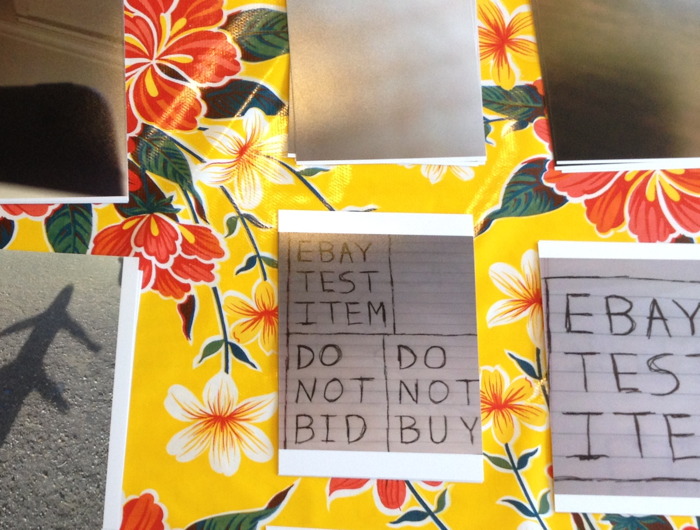
A rare and exclusive selection of Local Pick-up Only #eBayTestListing prints. Because price and shipping parameters are intrinsic aspects of the eBay Test Listing series, it was not conceptually reasonable to just stick a bunch of prints in a portfolio and sell them like crack on the street. So the only prints available at Yami-Ichi are those few whose eBay listings have local pick-up or store pickup options. Buy them right then and there on eBay, and take them home. Is how it will work.
OTO will also feature pieces from Yael Kanarek’s World of Awe; Waterbear flatware by Raphaele Shirley; canonical Before Facebook-era artifacts from MTAA; and the premiere of Sarff’s new audio project, Music 4 Music 4 Airports. Like I said, psyched and bewildered. Should be awesome.
Over The Opening (OTO) @ the Internet Yami-ichi (Internet Black Market) [mtaa.net]
On The Golden Record
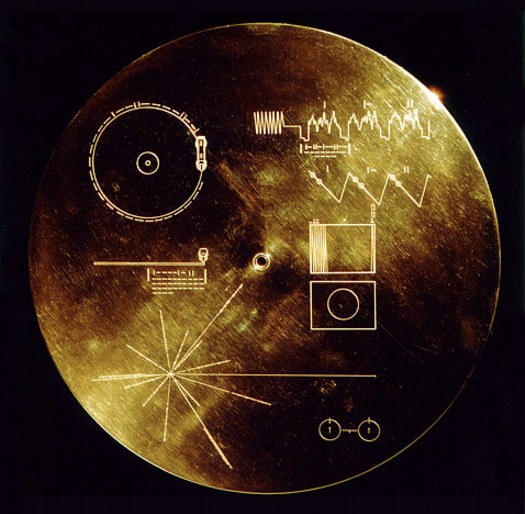
Could this really be happening? Four years ago I wished for a way to play back the Golden Record, the earthly calling card stuck to the sides of the Voyager space probes nearly 40 years ago. I knew all the recordings and diagrams and photos Carl Sagan and friends recorded on there, but I wondered what it would actually be like to play it back? What would the 116 images turn out like if you played them off an analog record with a needle, and then assembled the 512 raster lines?
I wanted to find an extra Golden Record and play it, which turned out to be hard-to-impossible. And also unnecessary. [Though I’m still game, if you have a Golden Record I can borrow!] Because the Record has been played.
A few weeks ago, Man Bartlett tweeted about some strange electronic passages in a NASA recording of the Golden Record:
@ranjit @ManBartlett @NASAVoyager here’s the IA version https://archive.org/details/Voyager1
— gregorg (@gregorg) August 6, 2015
And then sound artist Ranjit Bhatnagar identified them as the encoded data for the 116 photographs. Here’s one of the first images Ranjit processed, the aliens’ intro to Earth Math:
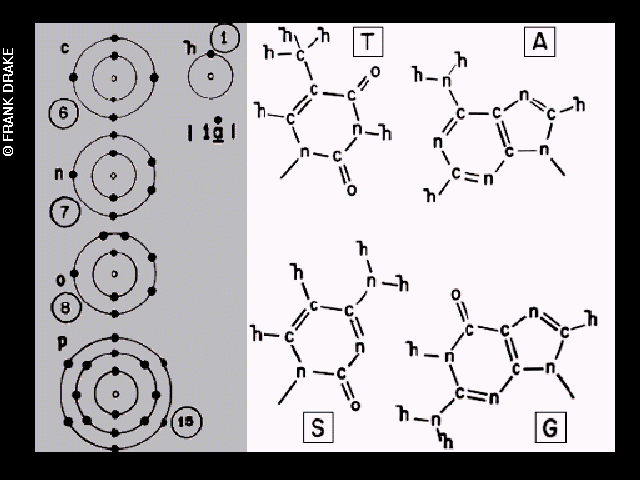
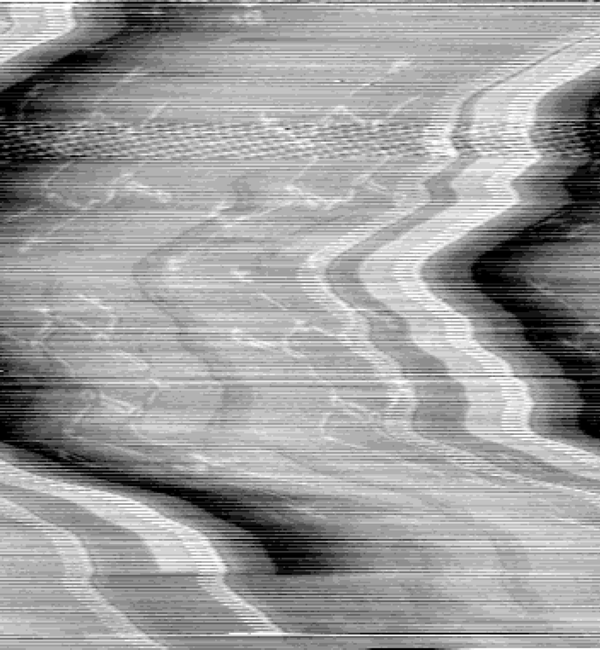
above: Image of math chemistry from Voyager 1 by Frank Drake, below: same image decoded by Ranjit Bhatnagar
@ManBartlett @NASAVoyager @gregorg here’s the intro to math page (and the original) pic.twitter.com/ATQYMpoZLz
— Ranjit Bhatnagar (@ranjit) August 6, 2015
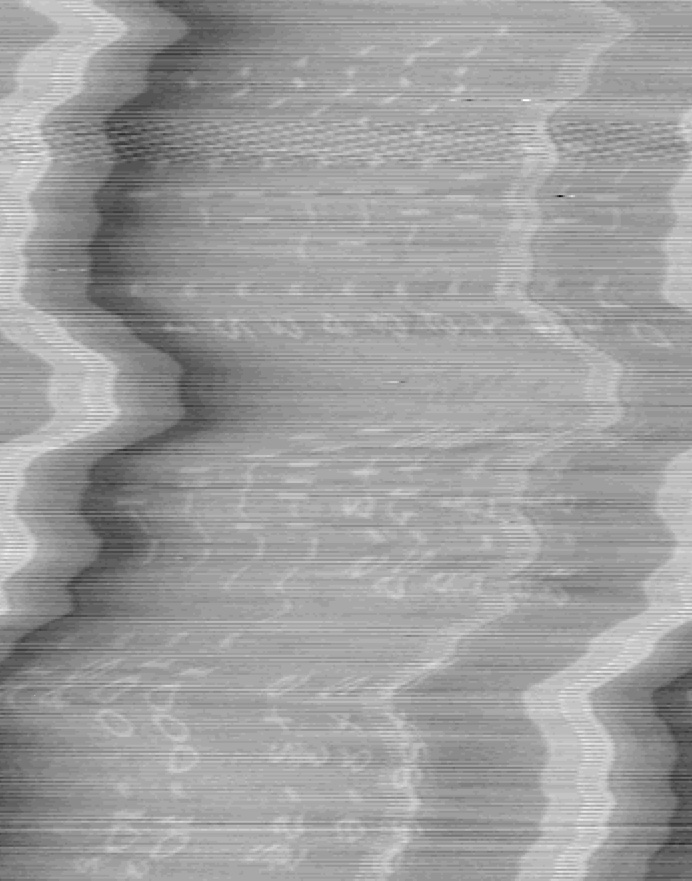 [images from ranjit’s tweet, decoded math above, and original below]
[images from ranjit’s tweet, decoded math above, and original below]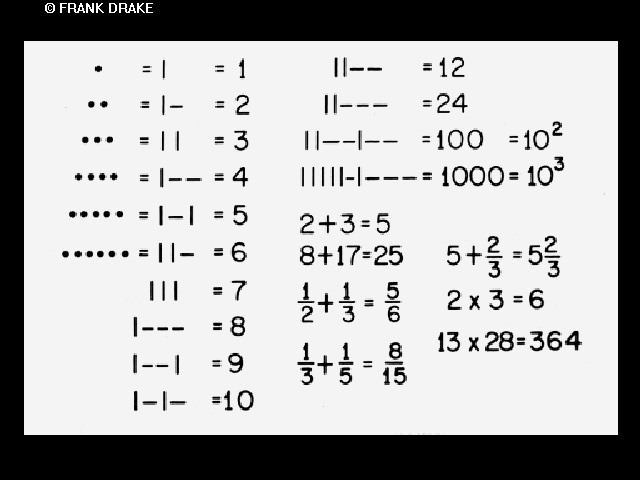
So this is it. The answer was sitting right there on the Internet Archive the whole time. And yet.
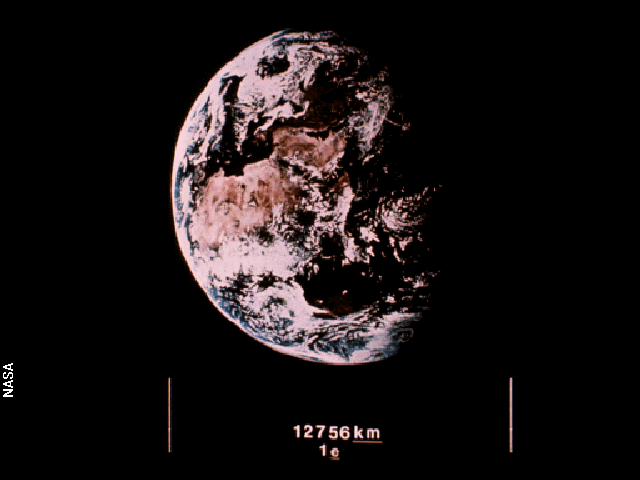
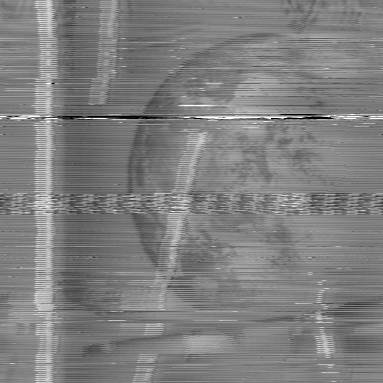
above/below: image of Earth, and image of Earth decoded from Voyager 1 by Kyle McDonald
Within a few minutes of Ranjit’s decoding, code artist Kyle McDonald happened by, and blew things wide open with his distortion adjustments, which he promptly documented and pushed to github. So it just took four years and one serendipitous hour. And now we know that the images we’ve sent out into the universe look like a 1970s TV with a tinfoil antenna.
Voyager1 audio track [archive.org]
Kyle McDonald | Voyager 1 Decoding [github]
Previously: Off The Golden Record
Better Read: Why We Should Talk About Cady Noland, A Zine By Brian Sholis

Cover, “Why We Should Talk About Cady Noland”, a zine published by Brian Sholis in 2004, image: archive.org
It’s been a while since I’ve put up an edition of Better Read, audio works made from worthwhile art texts read by a machine. But yesterday I listened to “Why We Should Talk About Cady Noland,” Brian Sholis’ 2004 zine essay while I was working, and I decided to clean it up for public enjoyment. Which basically involves extra punctuation marks to smooth the flow, and tweaking the spellings so the computer voice will read French or German plausibly.
As the title implies, Sholis’s essay argued for the continued relevance of Noland’s work and writing at a time when firsthand encounters with both were hard to come by. Now it’s also a useful reminder that there’s more to talk about than auction prices and lawsuits.
Better Read #004: Brian Sholis on Cady Noland 20150810.mp3 [dropbox greg.org, mp3, 8.3mb, 17:43]
Original text: Jan. 20, 2004: Cady Noland [briansholis.com via internet archive]
Previous Better Reads: #003 – Rosalind Krauss; #002 – Ray Johnson; #001, the ur-Better Read – W.H. Auden
Podcast: Play in new window | Download
Subscribe: RSS
New eBay Test Listings Prints

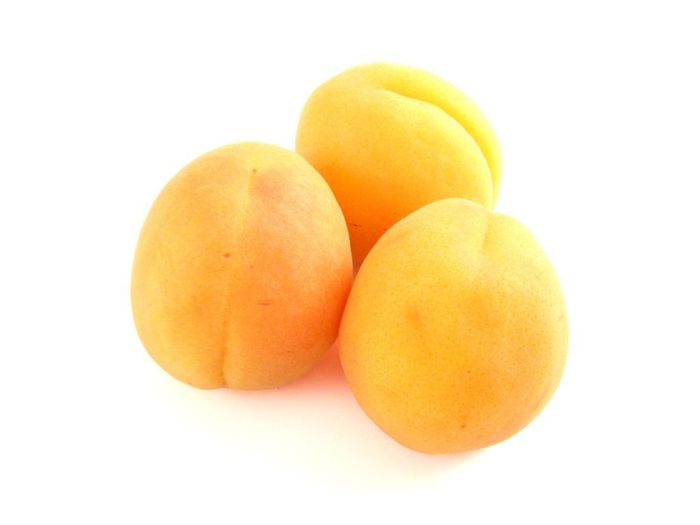
I have added some prints found during the earliest days of the eBay Test Listings project, but only made available now for sale and entertainment which, after all, are the same thing.
See all available eBay Test Listings prints on eBay [ebay]
Court Order, Or What Would Danh Vo Do?
What Would Danh Vo Do? Send in your proposal today! Must be “large and impressive”! #wwdvd
— gregorg (@gregorg) July 7, 2015
Oh no, I was too slow. I was in the middle of a deadline-intensive project when I suggested that. While I understood the reluctance, even the revulsion, an artist might feel, but being compelled by a judge to make a “large and impressive” artwork–and a $350,000 one, no less–sounded like a fascinating situation. What would you do?
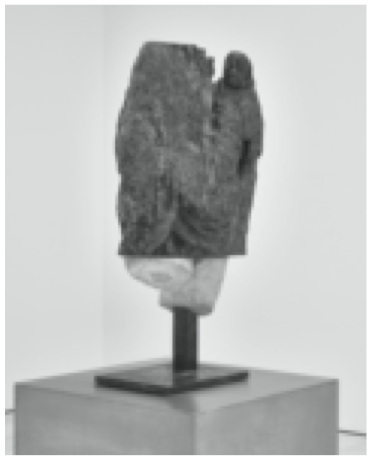
…, 2015, oak and polychrome Madonna and child, French Early Gothic 1280- 1320; marble torso of Apollo, Roman workshop, 1st-2nd century ad; steel 154.2 × 50 × 50 cm
Courtesy of the artist and Marian Goodman Gallery [works list (pdf) via palazzograssi.it]
Well, today, just as I was mapping out the parameters of my own proposal, Danh Vo apparently answered that question himself. His proposal to Dutch-in-Switzerland collector Bert Kreuk was a little unclear in the details, but it involves a quote from the demon possessing Regan in The Exorcist, which Vo had also used for a piece in his show at Marian Goodman in London last January, and which he included in “Slip of the Tongue,” his fantastic group show at Punta della Dogana in Venice. [I guess it’s still available. Ask for it by name!]
Maybe Vo already had this whole Kreuk/Gemeentemuseum/lawsuit situation on his mind when he chose The Exorcist for his source material. Who knows? But the artwork parameters cited in the court’s new ruling in Kreuk’s lawsuit are intriguing enough to lay out, and at least give some though to the question: What Would Danh Vo Do?
Lightning Field Notes
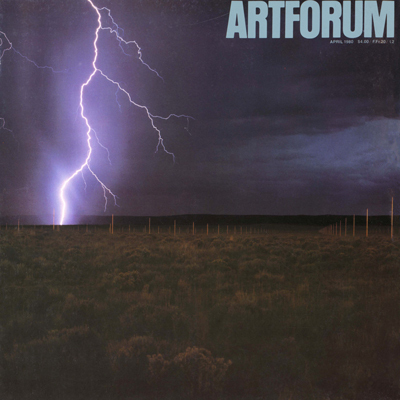
John Cliett’s photo of Walter de Maria’s The Lightning Field, 1977, on the cover of Artforum (Apr. 1980)
From the beginning, access to The Lightning Field has been tightly monitored by the administrative machine surrounding the project. Visitors to the site are required to spend the night and are not allowed to take photographs during their stay. Indeed the entire project is predicated on the viewer’s personal physical experience of the work in its location. Yet, at the same time, the artist and his patrons have also sought to stake out a particular presence in the wider discourse of contemporary art for The Lightning Field, a goal they have accomplished in part through a carefully orchestrated approach to photographic documentation.
[John] Cliett worked from the beginning with De Maria on formulating the scheme for photographing The Lightning Field; many of the most often-reproduced images of the Field, including those which famously introduced it to the art world in the pages of the April 1980 issue of Artforum magazine, come from his two summer sessions. Indeed, that so many viewers have come to know The Lightning Field through these images–a fraction of the total he took, strategically promulgated over the years by the artist and Dia–emphasizes their essential role in the artist’s plan for shaping the image and promoting the “idea” of the work.
Well beyond the artist’s own writing, Jeffrey Kastner’s interview with The Lightning Field photographer John Cliett has been central to my understanding of the work since 2001.
Cliett told of taking the extraordinary, iconic, and extremely difficult pictures of The Lightning Field, but also of how images are antithetical to de Maria’s concept for the work. This contradiction between the artwork and the art system surrounding it generated tension similar to other Land Art. During the 1970s and 80s when Robert Smithson’s Spiral Jetty was considered “lost” or invisible under the Great Salt Lake, the artist’s film became the focus of critical attention.
De Maria felt that even this iconic imagery, which Cliett later jokingly compared to “a Pink Floyd album cover,” could only ever fail to communicate the experience of the work. “Walter’s work is designed to create an environment where a viewer can have a highly personal relationship with a work of art that is completely unique to each individual,” Cliett said.
But the images had another purpose, controlling the discussion of the work, as I was reminded when I re-read Kastner’s interview this summer:
With respect to the copyright, if you control the picture of a work of art, you will control everything that’s said about it, because nobody will publish an article without pictures. So you get the right to pick, and that’s a very powerful thing.
Yes, well.
After many discussions, dreams, and failed attempts over 22 years, we managed to get a trip to The Lightning Field together for this summer. We built the rest of our cross-country road trip around it and got home a couple of weeks ago. A visit takes basically 21 hours, starting at 2pm, no stragglers. Dia’s folks on the ground drive you to and from the remote site. There is room for six people in the cabin; in addition to our family of four, there was a young couple from Brooklyn.
I’m not sure when I decided to livetweet our visit to The Lightning Field, maybe after I started seeing people I knew from Twitter in the registry. Or when I read one excited, tweet-sized comment left by a dealer about soaking in the sublime, which seemed like a lot to feel before you even get there. And so as I was about to learn the difference between an image and an artwork, I started thinking about real and virtual, individual and network, living and publishing, an account and an experience, a livetweet and IRL.
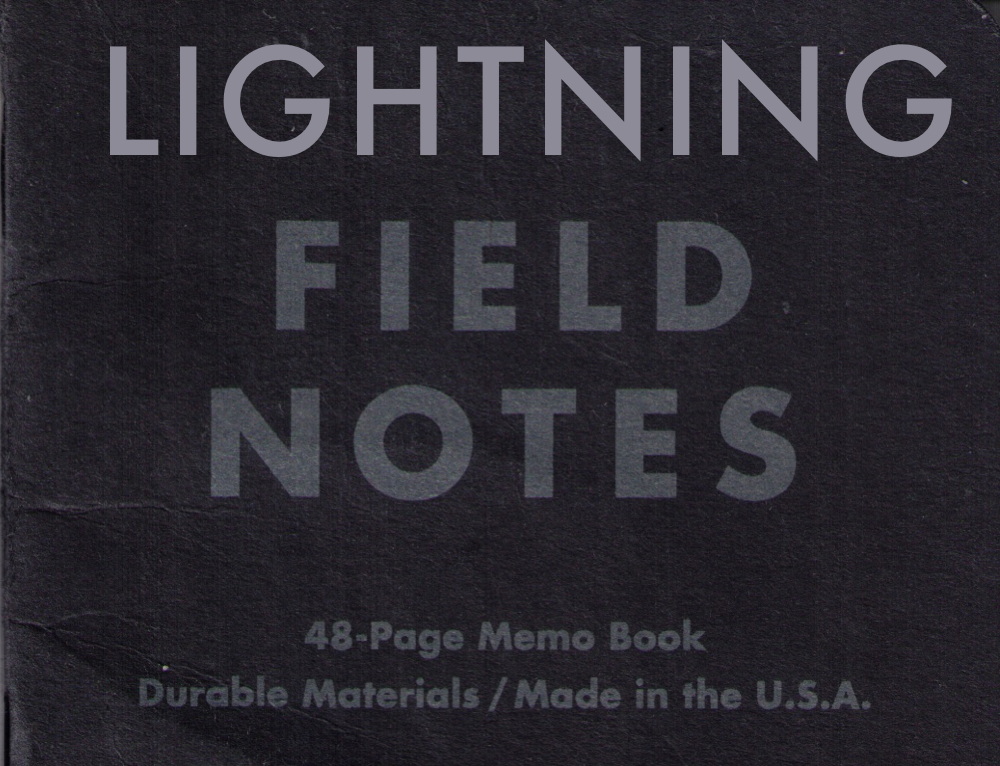
Without wanting to blow my actual encounter with The Lightning Field, I was interested to isolate what happens when you approach an experience with a livetweeting mindset: do livetweeters dream of 140-character sheep? Since there was cameraphones, and no hope of connectivity anyway, I decided to write my tweets down. My black Field Notes book looks very iPhone-ish, and I was quickly aware of being glued to it like any other screen, so I did not write every tweet in real time; I’d put some in my mental drafts folder and batch them.
There’s still a lot that didn’t make it in. Stuff I left out. But from there, also what de Maria left out. After several ventures into and around the Field, the artist’s almost total silence on the land itself is stunning. “The land is not the setting for the work but part of the work,” wrote de Maria, in bold, at the beginning of his Artforum essay. He wrote that the site was “searched by truck over a five-year period,” and that’s about it. The entire rest of his statement is about the hyper-precise calculations, surveying, and technical challenges of manufacturing and installing the poles. There are two pages of credits for the companies and construction workers involved.
Like Cliett’s photos, de Maria’s industrial fetish text was intended to manage the discourse around the work. No one could dismiss it as nonsensical, non-serious or unintentional. And it’s not some basement project, either; this is not your grandpappy’s mile of fence. Yet the only way to get around The Lightning Field is on foot, and the landscape makes you literally watch every step. And then there were the coyotes howling at sunrise, hoo boy, that was freaky.
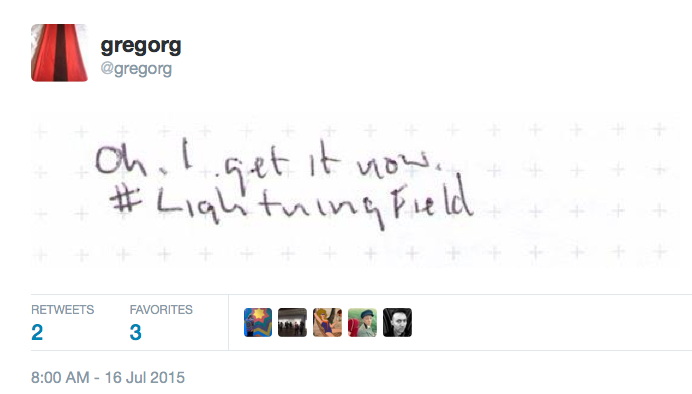
I ended the livetweeting right before our ride came, but one of the most interesting parts for me was the drive back to town, and the conversation with Kim, the longtime Dia staffer who runs the guest program on the ground. I decided not to tweet that, though, just as I didn’t really mention our cabinmates too much. Besides basic respect for their privacy, I figure that’s also truer to the work: tweets aren’t reporting, but a reflection of a single, individual experience.
Once I had this notebook of tweets, I had to figure out what to do with it. I scanned them and figured I’d play them back, tweet them in real time. That idea quickly ran afoul of my schedule. I guess I could have set a script to automatically post them at the prescribed times, but instead I tweeted each by hand, beginning yesterday at around 2 o’clock New Mexico time. I didn’t anticipate the friction of overlaying this recap of The Lightning Field with my back-to-normal life. Where visiting The Lightning Field was an intensely physical experience, livetweeting The Lightning Field became all about time. I could not anticipate the next tweet accurately; I was always way too early. I got in trouble for tweeting at the dinner table. I realized only after I started that twitter-as-usual would kind of blow the whole thing, so I stopped retweeting and responding to people until it was done. [Sorry!]
I may work the tweets up into an edition, a facsimile notebook or something. Dan Perjovschi made a little sketchbook facsimile for Kunsthalle Basel a few years ago that I like, and Field Notes are the perfect on-brand readymade. Or maybe I’ll do some other project, involving barnwood, Hudson’s Bay blankets and yoga mats. I don’t know yet, but something’s sure to come of it.
Untitled (Screenshot), 2015
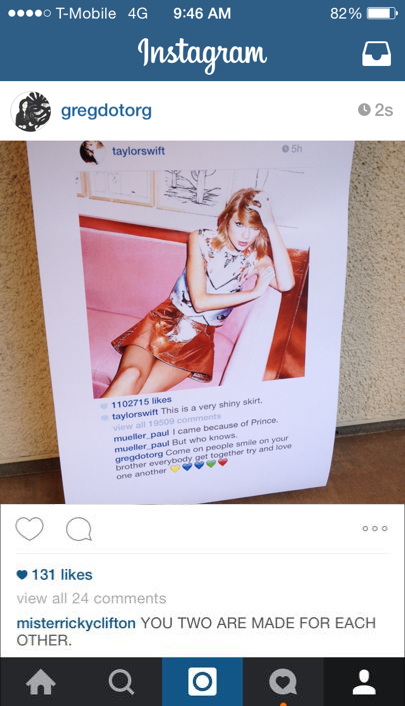
“I came because of Prince.” Untitled (Screenshot), 2015, png
cf. @gregorg. ibid.
